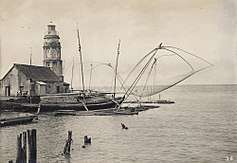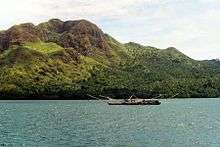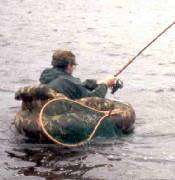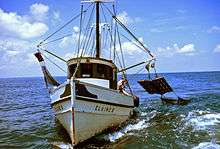Lift net
Lift nets, also called lever nets, are a method of fishing using nets that are submerged to a certain depth and then lifted out of the water vertically. The nets can be flat or shaped like a bag, a rectangle, a pyramid, or a cone. Lift nets can be hand-operated, boat-operated, or shore-operated. They typically use bait or a light-source as a fish-attractor.[1] Lift nets are also sometimes called "dip nets", though that term applies more accurately to hand nets.[2]
.jpg)
Types
Portable hand lift nets
Portable hand lift nets are small lift nets operated manually. They usually have a rigid frame which is attached to a long pole. They are used primarily to catch fish and crustaceans, and may be submerged just below the water surface or close to the bottom. A person using hand lift nets usually operate it from the shore, on bridges, and from harbor walls.[3]
Shore-operated stationary lift nets
Stationary lift nets are larger than hand lift nets and are attached permanently to a shore-built structure. Lifting the nets may be done by hand through the use of counterweights, or they may use mechanized winches. Bait or a strong source of light is placed in the middle of the net. They are typically placed near beaches or riverbanks.[4]

.jpg)

.jpg) Dhormo/Bheshal jal lift nets in Bangladesh
Dhormo/Bheshal jal lift nets in Bangladesh
Boat-operated lift nets
Boat-operated lift nets are lift nets operated from water vessels. They may be lifted up by hand or by mechanical winches. They usually utilize several long poles attached to one side of the boat or surrounding the boat. Bait or a strong source of light is used to attract the fish.[5]




 A basnigan from the Philippines with lift nets deployed
A basnigan from the Philippines with lift nets deployed
See also
| Wikimedia Commons has media related to Lift nets. |
References
- "Lift Nets". Fisheries and Aquaculture Department. Food and Agriculture Organization of the United Nations. Retrieved 1 July 2018.
- Gunzo Kawamura & Teodora Bagarinao (1980). "Fishing Methods and Gears in Panay Island, Philippines". Memoirs of Faculty of Fisheries Kagoshima University. 29: 81–121.
- "Portable Lift Nets". Fisheries and Aquaculture Department. Food and Agriculture Organization of the United Nations. Retrieved 1 July 2018.
- "Shore-operated Stationary Lift Nets". Fisheries and Aquaculture Department. Food and Agriculture Organization of the United Nations. Retrieved 1 July 2018.
- "Boat-operated Lift Nets". Fisheries and Aquaculture Department. Food and Agriculture Organization of the United Nations. Retrieved 1 July 2018.





